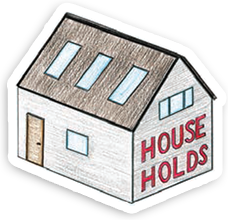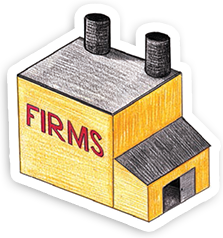The circular flow of money, goods and services is a simple model to demonstrate how the economy functions. In its simplest form, it describes the flow of money, goods, resources, and services between households and firms.
A household consists of an individual or a group of people who live together and share income, such as you and your family.
A firm is a privately owned organization that produces goods or services and sells them to others.


Throughout this activity, click or tap on the circular flow diagrams to learn more.
The simplest form of circular flow diagram includes only households and firms. Goods and services flow from firms to households, in return for money that flows from households to firms. At the same time, households provide resources that firms need to make goods and services, in return for income. The flow of goods and services is always in the opposite direction of the flow of money.
Resources are factors of production firms need, such as labor, land, capital, and entrepreneurship, to produce goods and services.
Income is money earned by households for providing resources firms use to produce goods and services.
Goods and services are products made by firms for sale to households.
Purchases are money households spend to buy needed or desired goods or services.
There is more than one firm producing goods and services, and more than one household buying those goods and services. All of these buyers and sellers together make up the product market.
Revenue is money firms receive in exchange for the goods and services they provide.
In the same way, all households with resources to sell to firms, and all the firms that buy the resources, make up the factor market.
Factor payments are money firms spend buying resources they need to produce goods and services.
Did You Get It?
What kind of resources do households mainly provide to firms?
Households and firms receive goods and services from governments. Fire and police protection are examples of services households receive from governments.
The government collects taxes from households and firms in order to buy needed products and resources in the product and factor markets. Personal and corporate income taxes are examples of taxes that fund governments.
The government also pays money directly to households and firms. These payments, such as Social Security payments or farm subsidies, are called transfers.
Governments buy the products and resources they require in the product and factor markets. Fire trucks and the labor of firefighters are examples of government purchases.
Did You Get It?
What is the source of government income?
The circular flow diagram provides an overview of economic activity.
The diagram can be as detailed as needed.
For example, the product market in this diagram could be divided to show how much of the flow is goods, and how much is services. The dollar value of each flow could be added to the diagram.
Wrap Up
A circular flow diagram illustrates the interactions between key players in the economy.
For more information on circular flow diagrams, read Chapter 2, Module 6 of Explorations in Economics and study the Module 6 Review and Assessment. You can also test yourself with the Module 6 online quiz here on the BCS.